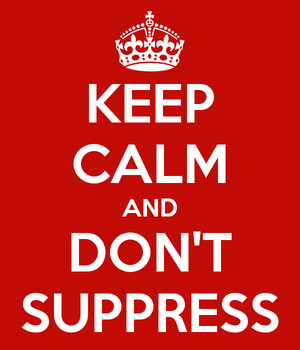As someone who teaches (and writes about) mindfulness and meditation, I spend a lot of time addressing misconceptions.
There are many out there, and they are repeated often. Even more disheartening is that a lot of “teachers” and resources spread them, which makes it critical for people coming to mindfulness and meditation to find proper instruction.
Some of the more prevalent misconceptions are:
- Meditating is about stopping thoughts or clearing your mind.
- Meditating is about forcing yourself to think certain thoughts (or, block certain thoughts).
- Meditating will make you “detached” and non-caring/non-feeling.
- Meditating can cause more thoughts, and make depression and anxiety (and other conditions) worse.
All of these are false, and I’ve addressed them in past articles.
Recently, the misconception I’ve seen most is “meditating causes (or instructs) you to suppress thoughts and emotions.” I’ve witnessed heated debates on this topic, and read a lot of erroneous information.
This misconception stems from a fundamental misunderstanding of meditation. When you meditate, you cultivate awareness of everything that appears in consciousness: thoughts, emotions, urges, sensations, etc. You develop the skill of noticing it all without getting caught up in it (without indulging it).
On the other hand, suppress is defined as “forcibly put an end to; prevent.” Meditation is the opposite of that definition — when you meditate, you aren’t trying to forcibly end or prevent anything. To the contrary, you accept it all non-judgmentally.
Put another way, meditation is embracing whatever is happening in the present moment. The distinction, however, is that meditating isn’t wallowing in thoughts and emotions. Nor is it dwelling on or analyzing them.
Wallowing, dwelling, and analyzing are more mental gymnastics, and they perpetuate being caught up in your mind.
The reason we meditate is to stop being caught up in our minds, however. It’s to stop following them down a path that culminates in conditioned behavior (decisions, actions, reactions).
Instead of “x” thought leading to “y” emotion leading to “z” action, awareness creates space that allows you to see the thought and feel the emotion without being clouded by mental constructs and biases. As such, you can make better decisions and take more skillful actions.
I refer to this as taking your life off autopilot; you are no longer at the mercy of the next thought, emotion, or urge that pops into your head.
A few words on the process — when you meditate, you focus your attention on an anchor. At some point, you will become aware of (notice) thoughts. When you do, return your attention to the anchor. This is how you develop the aforementioned skill — you notice and return, over and over again.
Some might argue that the act of moving from thought back to your anchor is suppression, but that is not correct. You aren’t “forcibly ending” or preventing anything. Instead, you acknowledge what arises and move your attention away from it.
To further prove this point — if you move your attention away from a sound, are you suppressing it? Every second we are surrounded by sounds: people moving about, traffic, birds chirping; there is a never-ending background noise to our lives.
Short of putting on headphones or using earplugs, we don’t suppress it. We usually choose to move our attention to something else, but the sounds are still there regardless. It’s no different with your mind-made activity.
In conclusion, don’t try to suppress thoughts and emotions — meditation doesn’t teach that. Don’t try to stop or control your mind-made activity in any way — meditation doesn’t teach that either.
What it does teach is to become aware of everything. It teaches you to notice thoughts and emotions: watch them as they arise, don’t get caught up in them, and return your attention to the anchor.
In short, it teaches you to stop blindly following your mind wherever it leads.
Mindfulness is the awareness that arises through paying attention on purpose in the present moment…non-judgmentally. — Jon Kabat-Zinn
From: Medium

